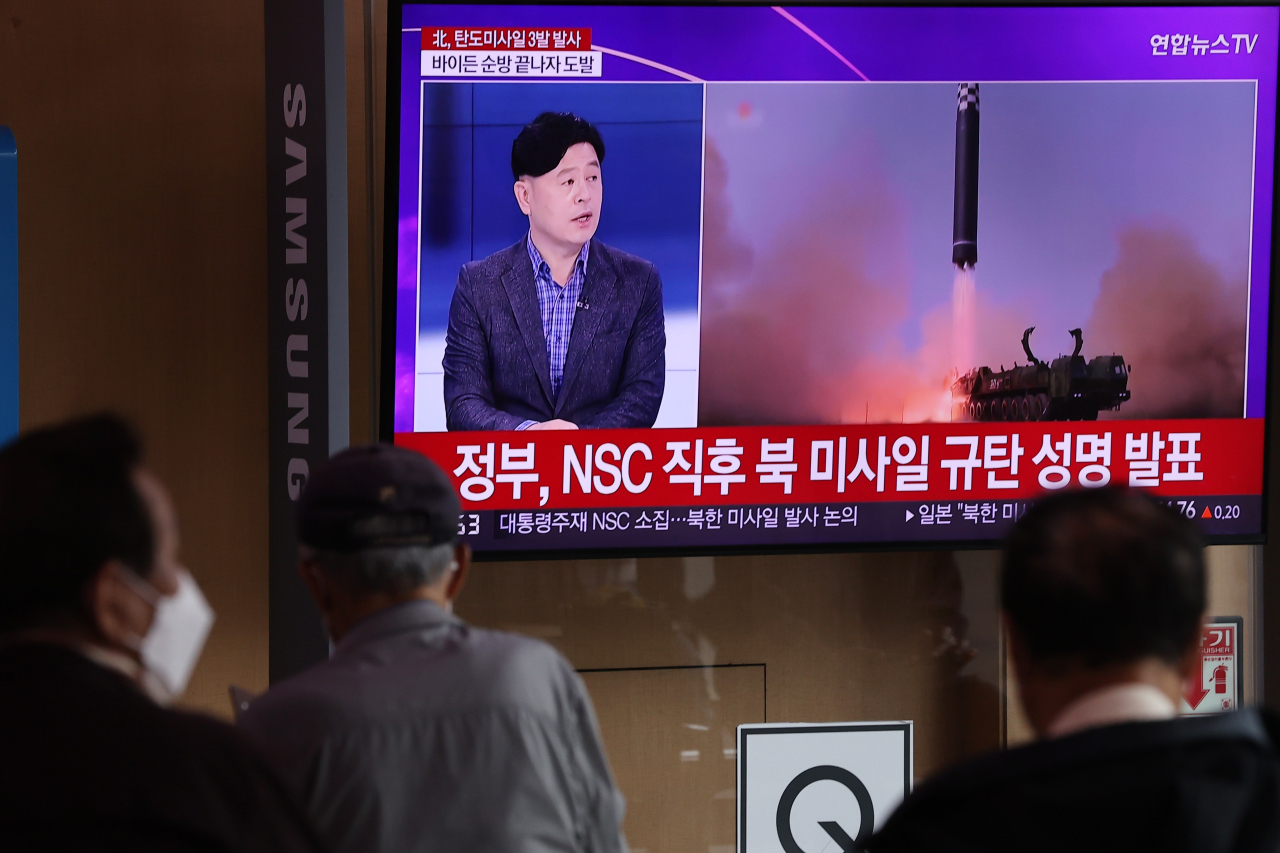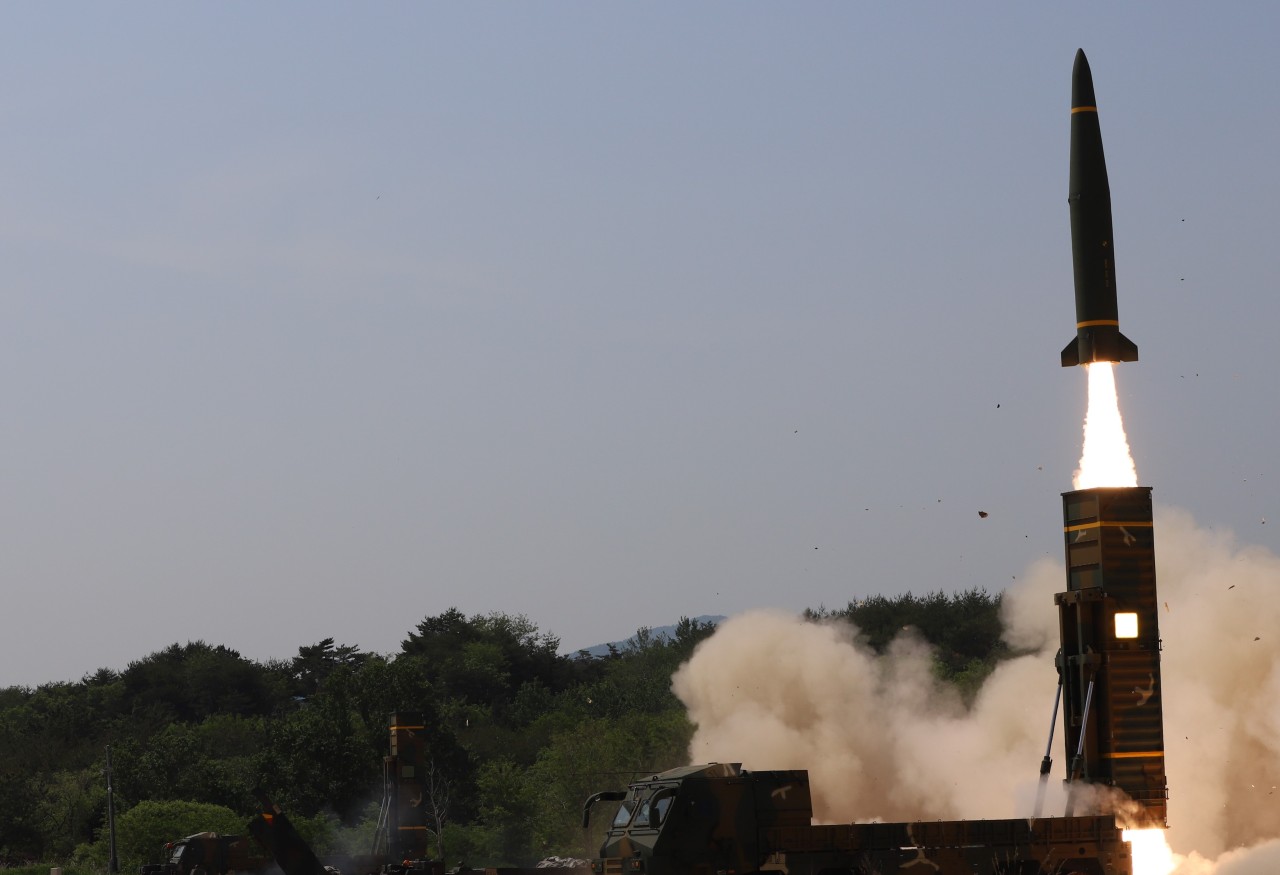
Passersby watch a TV report of North Korea`s missile launch at Seoul Station on Wednesday (Yonhap).
North Korea fired a suspected intercontinental ballistic missile and two other ballistic missiles toward the waters off its east coast early on Wednesday, the South Korean military said, just one day after US President Joe Biden wrapped up his first trip to Asia.
A total of three ballistic missiles were launched from the Sunan area in the capital city of Pyongyang at around 6 a.m., 6:37 a.m. and 6:42 a.m., respectively, South Korea’s Joint Chiefs of Staff said in a statement.
North Korea fired a suspected ICBM, which traveled around 360 kilometers at a speed of Mach 8.9 and reached an altitude of around 540 km, according to the JCS.
The South Korean military views that North Korea is likely to have fired a new Hwasong-17 ICBM and claim the launch was to develop a satellite, The Korea Herald learned. The first stage was reportedly separated after the propellant ignition despite questions remaining on whether the launch was successful.
South Korea’s JCS said a suspected short-range ballistic missile (SRBM) was subsequently launched. The missile went undetected and “vanished” after reaching an altitude of 20 km, but further analysis is needed to confirm whether the launch ended in failure.
North Korea also fired what appeared to be another SRBM, which flew around 760 km at an altitude of 60 km and at a speed of Mach 6.6.
The South Korean military has braced for the possibility of North Korea firing KN-23 solid-propellant SRBMs, which have greater maneuverability and conduct “pull-up maneuvers” in flight that can evade and penetrate South Korea and US’ missile defenses.
S. Korea-US alliance response South Korea’s JCS said the military on Tuesday independently conducted “Elephant Walk” Air Force training involving around 30 fully armed F-15K fighter jets in preparation for missile launches after detecting the signs in advance.
South Korea and the US on Wednesday conducted a combined live-fire exercise at around 10:20 a.m. to “demonstrate the prompt strike capability of the combined force to deter further provocations by North Korea,” JCS said. South Korea’s Hyunmoo-2 short-range ballistic missile and one US Army Tactical Missile System missile were fired in Gangneung, Gangwon Province.
“Our military’s show of force demonstrates the will to sternly respond to any provocations by North Korea, including an ICBM launch,” the JCS said. The independent and joint military drills also prove that the South Korean military has the ability and maintains readiness to “precisely strike the origin of provocations with overwhelming military power,” it said.
The United States Forces Korea underlined that the US commitment to defend South Korea “remains ironclad” in a statement issued after the live-fire drill.
Soon after the latest launch, South Korea’s JCS Chairman Gen. Won In-choul and Gen. Paul LaCamera, the commander of the South Korea-US Combined Forces Command, held a video conference sharing information and reaffirmed their commitment to making the combined defense posture more robust, the JCS here said.
South Korean Defense Minister Lee Jong-sup and US Secretary of Defense Lloyd Austin on Wednesday shared their assessment of the missile launches and countermeasures during a phone call.
Lee and Austin “strongly condemned North Korea’s consecutive ballistic missile launches as the grave provocation that threatens peace on the Korean Peninsula and the world as the act flagrantly violates the UN Security Council resolutions.”
The two defense chiefs commit to “further reinforcing the South Korea-US combined defense posture and the US extended deterrence in response to North Korea’s continued provocations and strongly and effectively responding to any kind of provocations made by North Korea in the future.”

South Korea and the US on Wednesday conducted a combined live-fire exercise at around 10:20 a.m. to “demonstrate the prompt strike capability of the combined force to deter further provocations by North Korea,” JCS said. South Korea’s Hyunmoo-2 short-range ballistic missile and one US Army Tactical Missile System (ATACMS) missile were fired in Gangneung, Gangwon Province.
Seoul-based experts said North Korea’s planned missile launches mainly aim to deliver a message to the Biden administration. It was also to protest against the US move to rally its allies and partners in the Indo-Pacific region to address key security challenges including mounting missile and nuclear threats posed by North Korea.
The missile launches came hours after Biden left the Asia-Pacific region and just before he arrived in the US.
North Korea sought to “bluntly express discontent” over Biden’s first trip to Asia in light of the timing and formation of the missile launches, said Hong Min, a director of the North Korean Research Division at the government-funded Korea Institute for National Unification.
“The timing of the missile launches is highly calibrated and planned,” Hong told The Korea Herald. “The launches are deemed as North Korea’s active response to Biden’s messages delivered during his trip to South Korea and Japan.”
Biden committed to enhancing the US’ extended deterrence to defend South Korea and Japan against North Korea’s mounting missile and nuclear threats.
During the South Korea-US summit, the two leaders on Saturday agreed to initiate dialogue to expand the scope and scale of combined military exercises on and around the Korean Peninsula, citing the “evolving threat” posed by North Korea as the reason.
Biden reaffirmed the US’ extended deterrence commitment to South Korea “using the full range of US defense capabilities, including nuclear, conventional, and missile defense capabilities,” according to the South Korea-US joint statement.
Park Won-gon, a professor from Seoul’s Ewha Womans University, pointed out that the South Korea-US summit especially heralds the resumption of the large-scale South Korea-US combined military exercises and the deployment of the US strategic assets on the Korean Peninsula.
“North Korea considers the agenda topics to be at the forefront of the hostile policy against the country. Reinforcing the US extended deterrence also runs counter to the prerequisites for the ‘denuclearization of the Korean Peninsula’ claimed by North Korea,” Park said. “North Korea is up in arms (about the decisions) and sends the message of protest by launching the missiles.”
Backlash against strengthening alliance deterrence
Hong took note that the joint statement listed a wide range of measures to enhance the alliance’s deterrent capabilities against North Korea including strengthening the US missile defense system.
“The missiles North Korea launched today are the weapons that can demonstrate the country’s will and response capability against the joint move,” Hong said.
The ICBM is a strategic weapon that can hit the US mainland, aimed at alliance decoupling and undermining the US extended deterrence commitment. In addition, North Korea has pursued developing short-range missiles with greater maneuverability such as the KN-23 to incapacitate US and South Korea’s missile defense system in the region.
“Kim’s trying to weaken the US-ROK missile defense. What should be clear to Kim now, under the Yoon administration, is that he will need to redouble efforts to weaken the US-South Korea alliance,” Soo Kim, a policy analyst at the Rand Corp. and a former CIA analyst, told The Korea Herald.
Soo Kim said the joint pledge by Seoul and Washington to work closely on the North Korea issue and the broader regional challenges “does not bode well” for North Korean leader Kim Jong-un. But Pyongyang will “continue to intensify its provocations” despite the alliance’s efforts to enhance the combined readiness posture.
“The closer and more intertwined Seoul and Washington become, the greater the intensity of Kim’s wrath -- manifest in the form of weapons testing.”
Clear signal: N. Korea on its wayIn a nutshell, North Korea’s core message is to push ahead with developing and expanding missiles and nuclear weapons, Cha Du-hyeogn, a principal fellow at the Asan Institute for Policy Studies, told The Korea Herald. The message is an apparent countermove to the pronouncement by the South Korean and US leaders to shift toward a hard-line stance on North Korea and put more weight on achieving the complete denuclearization of the Korean Peninsula.
“As indicated in the leaders’ joint statement, South Korea and the US send the clear message that their North Korea policy will neither solely seek dialogue nor conciliatory moves,” Cha said. “In response to the direction, North Korea now in effect says that it will go on its way.”
Cha also took note that the Kim Jong-un regime could capitalize on the choreographed missile launches to demonstrate the trilateral coalition among North Korea, China and Russia and its will to reinforce it.
South Korea, the US and Japan committed to enhancing their trilateral coordination in handling key security challenges including North Korea’s missile and nuclear threats during Biden’s trip to Asia.
Cha also pointed out that the ballistic missile launches came a day after multiple Chinese and Russian military aircraft on Tuesday intruded on South Korea’s air defense identification zone. The intrusion took place when leaders from the US, Japan, India and Australia were in Tokyo for an in-person meeting of the Quadrilateral Security Dialogue or Quad, which has irked China and Russia.
“Through the missile launches, North Korea seeks to signal that it will respond to the trilateral move among South Korea, the US and Japan by stepping up its cooperation with China and Russia,” Cha said.
(dagyumji@heraldcorp.com)







![[KH Explains] Hyundai's full hybrid edge to pay off amid slow transition to pure EVs](http://res.heraldm.com/phpwas/restmb_idxmake.php?idx=645&simg=/content/image/2024/04/18/20240418050645_0.jpg&u=20240419100350)